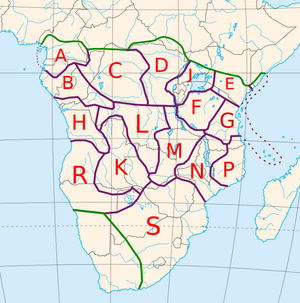Our website is made possible by displaying online advertisements to our visitors.
Please consider supporting us by disabling your ad blocker.
Guthrie classification of Bantu languages
| Bantu | |
|---|---|
| Narrow Bantu | |
| Geographic distribution | Africa, from approximately the equator south |
| Linguistic classification | Niger–Congo? |
| Subdivisions |
|
| Language codes | |
| Glottolog | narr1281 |
 The approximate locations of the sixteen Guthrie Bantu zones, including the addition of a zone J | |
The 250 or so "Narrow Bantu languages" are conventionally divided up into geographic zones first proposed by Malcolm Guthrie (1967–1971).[1] These were assigned letters A–S and divided into decades (groups A10, A20, etc.); individual languages were assigned unit numbers (A11, A12, etc.), and dialects further subdivided (A11a, A11b, etc.). This coding system has become the standard for identifying Bantu languages; it was a practical way to distinguish many ambiguously named languages before the introduction of ISO 639-3 coding, and it continues to be widely used. Only Guthrie's Zone S is (sometimes) considered to be a genealogical group. Since Guthrie's time a Zone J (made of languages formerly classified in groups D and E) has been set up as another possible genealogical group bordering the Great Lakes.
The list is first summarized, with links to articles on accepted groups of Bantu languages (bold decade headings). Following that is the complete 1948[2] list, as updated by Guthrie in 1971 and by J. F. Maho in 2009.
Previous Page Next Page
Clasificación de Guthrie de les llingües bantús AST Classificació de Guthrie de les llengües bantus Catalan Guthrie-Klassifikation der Bantusprachen German Clasificación de Guthrie de las lenguas bantúes Spanish Classification des langues bantoues selon Guthrie French 거스리의 반투어군 분류 Korean Guthrie-nummer NN


